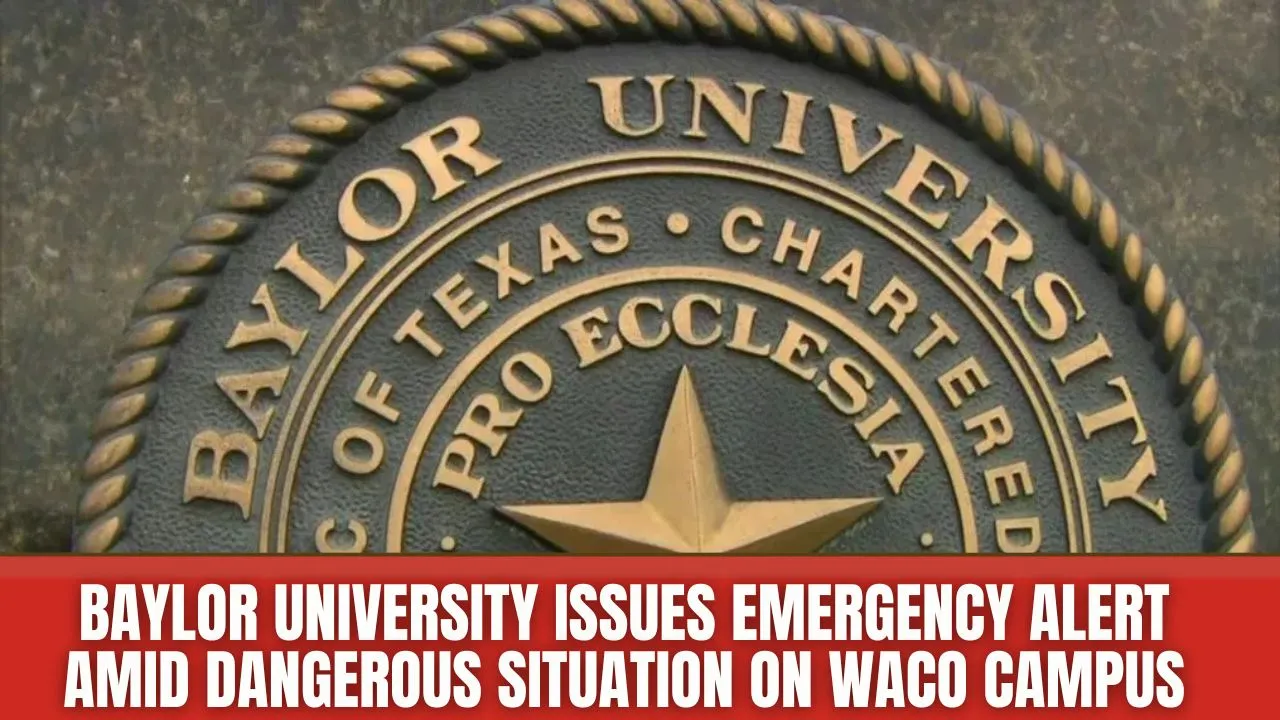Baylor University emergency alert: Baylor University found itself at the center of an unexpected security scare on June 26, 2025. A regular Thursday quickly escalated into a tense afternoon when the university issued an urgent emergency alert instructing students, staff, and visitors to shelter in place. The message, delivered across all official channels, was clear and commanding: “THIS IS NOT A DRILL.”
As the situation developed, concern swept across campus and the surrounding Waco community. Though it was later clarified that there was no active shooter, the university acted swiftly and responsibly to protect everyone on-site. This article details the sequence of events, official responses, and the safety measures taken during the Baylor University emergency alert, providing both insight and clarity on a day many won’t soon forget.
Baylor University emergency alert
The Baylor University emergency alert was issued following a high-speed police pursuit that ended dangerously close to the Waco campus. The chase began after a Kia SUV refused to stop for Texas Department of Public Safety (DPS) troopers. When the vehicle exited at Bagby Avenue, three suspects fled on foot, prompting fears they may enter campus grounds. Though it was quickly confirmed there was no active shooter, the uncertainty around the suspects’ location led to an immediate shelter-in-place order. One suspect was later taken into custody, and the university declared the campus safe by the evening. This incident emphasized the importance of rapid communication, community alertness, and law enforcement coordination.
Overview Table of Key Details
| Key Point | Information |
| Date of Incident | June 26, 2025 |
| Time of Alert | Approximately 12:26 PM CST |
| Initial Alert Message | “Dangerous situation on Waco Campus. THIS IS NOT A DRILL. Shelter in place now.” |
| Cause of Emergency | Vehicle pursuit by DPS; suspects fled near campus |
| Law Enforcement Agency | Texas Department of Public Safety (DPS) |
| Active Shooter Involved | No, confirmed by DPS |
| Suspects | 3 fled on foot; 1 apprehended later |
| Injury Reports | No confirmed injuries |
| University Response | Campus locked down, alerts issued, shelter order lifted by 5:19 PM CST |
| Communication Channels | X (Twitter), campus texts, emails, and loudspeakers |
Alert Issued After Vehicle Pursuit
The root of the chaos came from an unexpected police chase that unfolded just south of Waco. DPS troopers attempted to pull over a Kia SUV on I-35, but the vehicle didn’t stop. What followed was a high-speed pursuit through town, culminating near Baylor’s Waco campus. The suspects—three individuals inside the car—abandoned the vehicle and scattered on foot close to the university.
That proximity triggered an immediate alert. With three unidentified individuals on the run near a busy campus, Baylor’s decision to issue a shelter-in-place order was quick and appropriate. Even without confirmed weapons or violence, the unknown element posed a serious potential threat to student safety.
Shelter-in-Place Order and Campus Safety
Once the emergency alert went out, students and faculty were advised to find the nearest safe space and stay inside. The message warned people to stay away from doors and windows. While some students were in classes or residence halls, others had to quickly seek shelter in libraries, cafes, or academic buildings.
Thanks to Baylor’s well-established emergency notification system, communication was prompt. The use of multiple platforms—email, text messages, sirens, and social media—ensured that everyone received the message in real-time. Quick compliance from the campus community minimized risk and helped maintain order.
Law Enforcement’s Role and Response
Texas DPS played a central role in managing the unfolding event. According to Sergeant Ryan Howard, the agency was involved in the initial traffic stop and the ensuing chase. Once suspects fled near campus, DPS worked with local authorities and Baylor Police to search the surrounding areas.
They were quick to clarify that the incident was not an active shooter event, calming growing fears. However, with three people unaccounted for, caution remained necessary. Their coordinated presence around the campus perimeter ensured that the risk was mitigated, and the area remained under close surveillance.
Lifting the Alert and Resuming Normalcy
By late afternoon, university officials received confirmation that one suspect had been apprehended. With no continuing threat and no confirmed injuries, Baylor announced the end of the shelter-in-place order at around 5:19 PM CST. The update, posted to social media and campus communication systems, was a welcome relief to students and families who had spent hours in lockdown.
Classes and events resumed shortly afterward. Baylor’s leadership expressed gratitude to local law enforcement and praised the swift response from students and staff who followed safety protocols without hesitation.
Communication Channels Used
Effective crisis communication played a key role in the response’s success. The university’s use of social media, particularly X (formerly Twitter), allowed for real-time updates. Internal channels like emergency text alerts, campus emails, and building announcements reinforced the message.
The university’s preparedness—having a system in place and ready to activate—was crucial. In situations where time is everything, fast, clear communication can prevent chaos and confusion. Baylor’s example underscores the value of investing in robust emergency response infrastructure.
Aftermath and Continued Safety
Even after the shelter-in-place order was lifted, vigilance remained. While one suspect was in custody, the search for the other two continued. Baylor urged the community to remain alert and report any suspicious activity. The event served as a powerful reminder of how quickly a routine day can become a crisis.
Moving forward, the university is expected to review its emergency procedures and assess response times, effectiveness, and communication clarity. These reviews often help identify gaps and strengthen protocols for future incidents.
Bullet Point Highlights
- Incident Trigger: High-speed chase led suspects near campus
- Campus Action: Shelter-in-place order issued by Baylor immediately
- Active Shooter Clarification: DPS confirmed there was no gunfire or armed threat
- Suspect Update: One arrested, two remain unaccounted for
- Return to Normal: Alert lifted by evening, campus activities resumed
Why This Matters
- Preparedness: Baylor’s readiness helped maintain calm and safety
- Communication: Fast and multi-channel alerts are essential during campus emergencies
- Law Enforcement Support: Strong coordination between university and police matters
- Community Trust: Transparent updates help reduce panic and misinformation
- Lessons Learned: These events highlight areas for training, awareness, and future improvement
FAQs
Q1: What caused the Baylor University emergency alert?
The alert was triggered after suspects from a police chase fled near the campus, prompting immediate security measures.
Q2: Was anyone injured during the incident?
No injuries were reported. The situation was handled without harm to students or staff.
Q3: How did Baylor notify students and staff?
Through a combination of texts, emails, loudspeaker alerts, and social media updates on X.
Q4: Were the suspects armed?
As of the latest updates, there was no confirmation of weapons or an active shooter.
Q5: Is the campus safe now?
Yes, Baylor lifted the alert after confirming there was no ongoing threat. Classes and normal activities have resumed.
Final Thought
The Baylor University emergency alert reminded everyone of how quickly unexpected dangers can arise—and how crucial it is to be prepared. With swift action, efficient communication, and coordinated law enforcement support, Baylor turned a potential crisis into a model of calm, safety-focused response. Incidents like these reinforce the importance of staying informed and taking every alert seriously.
Call to Action: If you’re a student, parent, or university staff member, now’s the time to review your campus safety protocols. Share this article to spread awareness, and if you were affected or have insights to offer, leave a comment below. Let’s keep building safer, stronger communities—together.















